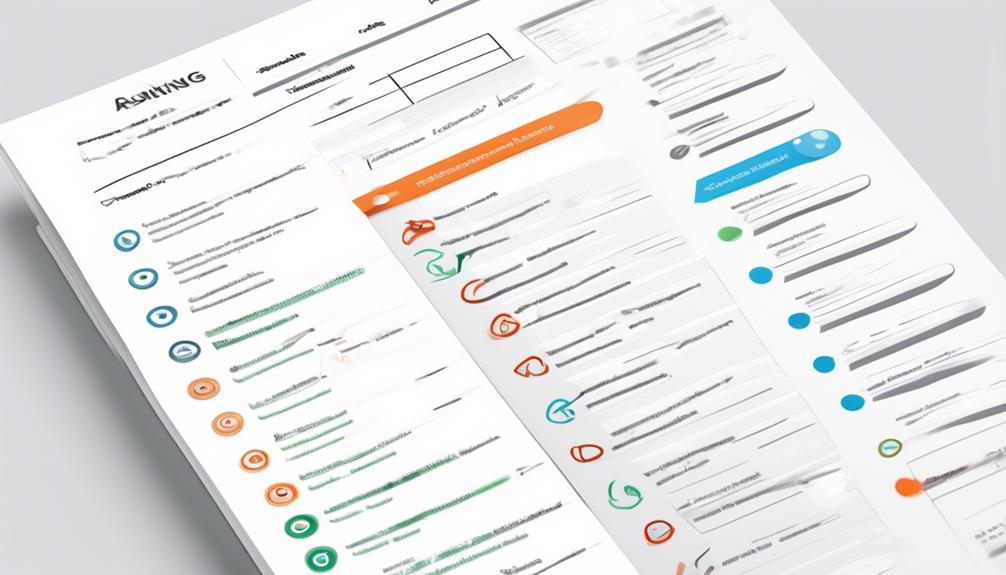When building a home, we focus on not just the end result but also on the foundation, material selection, and construction methods to ensure a strong and reliable structure.
Similarly, quality assurance in software testing is like the meticulous craftsmanship that goes into constructing a building. It’s about laying the groundwork, establishing standards, and meticulously examining each component to guarantee that the end product meets the highest quality criteria.
But what exactly does this process involve, and why is it so crucial in the world of software development?
Key Takeaways
- Quality Assurance in software testing involves setting and maintaining quality standards and procedures throughout the entire software development life cycle.
- It focuses on improving the end-to-end product development process, while Quality Control verifies product compliance with quality standards.
- A Quality Assurance Specialist plays a crucial role in ensuring software products or services meet established quality standards and guidelines.
- Best practices for Quality Assurance include implementing the PDCA Cycle for continuous improvement, embracing automation, shifting left testing approach, and gathering feedback for continuous improvement.
Understanding Quality Assurance in Software Testing
Quality assurance in software testing involves setting and maintaining quality standards and procedures to ensure that the product meets customer needs. It’s a meticulous process that encompasses the entire software development life cycle.
This includes continuous improvement and maintenance of processes to ensure high-quality production. QA activities involve creating guidelines, conducting measurements, and reviewing workflows.
These activities are essential for ensuring the quality of software products, improving the development process, and ultimately meeting customer needs.
Quality Assurance Vs Quality Control

Verifying product compliance with quality standards and focusing on detecting bugs in ready-to-use software is the primary aim of Quality Control (QC), distinct from Quality Assurance’s (QA) focus on improving the end-to-end product development life cycle. While QA sets quality standards, creates guidelines, and measures workflows to ensure continuous improvement, QC’s primary goal is to ensure that the final product meets these established standards. The table below provides a clear visual representation of the differences between Quality Assurance and Quality Control:
| Aspect | Quality Assurance | Quality Control |
|---|---|---|
| Focus | Improving the end-to-end product development life cycle | Verifying product compliance with quality standards |
| Activities | Setting standards, creating guidelines, measuring workflows | Testing and troubleshooting code in software development |
| Goal | Continuous improvement and maintenance of processes | Ensuring the final product meets established quality standards |
| Prevention vs Detection | Prevents malfunctioning code | Detects bugs in ready-to-use software |
| Role in Software Development | Integral part of the software development methodology | Integral part of software testing and engineering |
Understanding the distinctions between QA and QC is crucial for effective quality management in software engineering and development.
Role of Quality Assurance Specialist
Moving from the comparison of Quality Assurance versus Quality Control, the pivotal focus now shifts to the essential role of a Quality Assurance Specialist in software development.
Quality Assurance Specialists are pivotal in ensuring that software products or services meet established quality standards and guidelines. They play a crucial role in setting quality standards, creating guidelines, and conducting measurements to evaluate product quality.
Their work on continuous improvement and maintenance of processes ensures that customer needs are met. Additionally, Quality Assurance Specialists collaborate with external stakeholders and internal specialists to establish an environment for high-quality production. They also focus on improving the software development process, making it more efficient.
Their activities encompass a broad range of QA processes, testing activities, and ensuring adherence to quality standards to enhance product quality. In essence, Quality Assurance Specialists are the linchpin of maintaining and enhancing the quality of software products through their meticulous attention to detail and methodical approach.
Best Practices for Quality Assurance

Utilizing thorough preparations and strategic planning is essential to ensure the efficiency and effectiveness of quality assurance testing activities in software development. To achieve this, we recommend the following best practices for quality assurance:
- Implement the PDCA Cycle: Utilize the Plan-Do-Check-Act cycle as a defined approach for quality assurance processes. This methodical and iterative approach ensures continuous improvement and quality control throughout the software development lifecycle.
- Focus on Automation: Embrace automation to increase the speed, agility, and productivity of testing processes. Automation not only accelerates testing but also enhances the repeatability and reliability of test cases, leading to higher quality assurance (SQA) standards.
- Shift Left Testing Approach: Identify and rectify software defects early in the software development lifecycle to minimize rework and enhance overall quality. By shifting the focus to early stages, such as requirements and design phases, you can significantly reduce the occurrence of defects and streamline the development process.
- Gather Feedback for Continuous Improvement: Actively seek feedback from end-users and stakeholders to foster continuous improvement in software quality. This approach ensures that the software meets the evolving needs and expectations of the end-users, ultimately leading to higher satisfaction and quality assurance standards.
Quality Assurance Certifications
Obtaining quality assurance certifications demonstrates a professional’s expertise and proficiency in quality standards, processes, and methodologies, enhancing career opportunities and validating their knowledge in the field. These certifications are crucial for individuals seeking to establish themselves as experts in quality assurance within the software testing industry. Below, we have outlined some well-known Quality Assurance Certifications and their respective organizations:
| Certification | Organization |
|---|---|
| Certified Software Quality Analyst (CSQA) | Quality Assurance Institute (QAI) |
| Certified Quality Engineer (CQE) | American Society for Quality (ASQ) |
| Certified Manager of Quality/Organizational Excellence (CMQ/OE) | American Society for Quality (ASQ) |
| Certified Software Tester (CSTE) | Quality Assurance Institute (QAI) |
These certifications cover a range of competencies, including quality control, continuous improvement, and the Capability Maturity Model (CMM). They are highly regarded and widely recognized within the industry, providing professionals with a competitive edge in the job market and enhancing their ability to contribute effectively to any software project or testing environment.
Frequently Asked Questions
What Is Quality Assurance in Testing?
Quality assurance in testing ensures that software products meet stated and implied needs under specific conditions. We set quality standards, conduct measurements, and review workflows to improve the product development life cycle. Our focus is on continuous improvement and maintenance of processes to meet customer needs.
Activities include involving external stakeholders and creating guidelines to follow across the development process. This crucial role in delivering high-quality software is also known as QA Testing.
What Is Meant by Software Quality Assurance?
We ensure software quality assurance by:
- Setting standards
- Creating guidelines
- Measuring performance
- Reviewing workflows
Our focus is on continuous improvement and maintaining processes to meet customer needs. This approach ensures high-quality software delivery and improves the development process.
What Is the Role of QA in Software Testing?
We ensure the role of QA in software testing is to maintain and improve product quality throughout the development process. We set quality standards, create guidelines, and conduct measurements to review workflows.
Our focus is on continuous improvement to meet customer needs. Our QA activities encompass all aspects of the product development life cycle, ensuring that high-quality software is delivered to our customers.
What Are the 4 Types of Quality Assurance?
We can categorize quality assurance into four types:
- Preventive QA: This type focuses on establishing processes to prevent defects and issues from occurring in software development.
- Inspection QA: This type involves reviewing work products, such as code or documentation, to identify and address any errors or deficiencies.
- Testing QA: This type is responsible for ensuring that the software meets the specified requirements and functions as intended through various testing techniques and methodologies.
- Continuous QA: This type involves ongoing improvement efforts to enhance the quality of the software throughout its lifecycle.
Each type serves a distinct purpose in ensuring the quality of software. These types work together to maintain high-quality products.
Conclusion
In conclusion, Quality Assurance in software testing is essential for ensuring that software products meet quality standards and customer expectations. It plays a crucial role in improving the software development process and building trust with customers.
But how can we continue to adapt and evolve our quality assurance practices to meet the ever-changing demands of the software industry?









